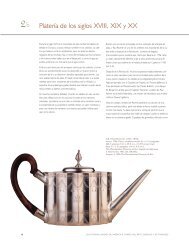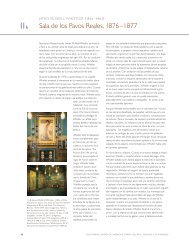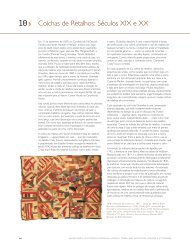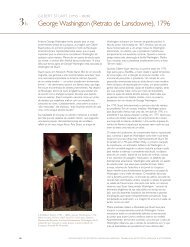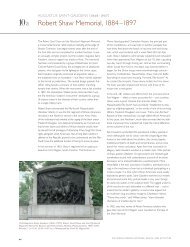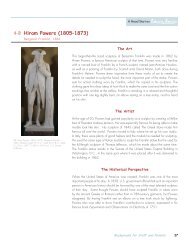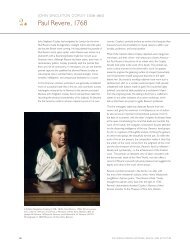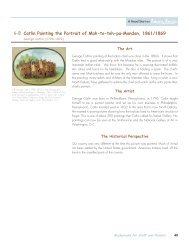Silver of the 18th,19th, & 20th Centuries - Picturing America
Silver of the 18th,19th, & 20th Centuries - Picturing America
Silver of the 18th,19th, & 20th Centuries - Picturing America
You also want an ePaper? Increase the reach of your titles
YUMPU automatically turns print PDFs into web optimized ePapers that Google loves.
2b<br />
12<br />
<strong>Silver</strong> <strong>of</strong> <strong>the</strong> 18 th ,19 th , & 20 th <strong>Centuries</strong><br />
During <strong>the</strong> seventeenth century, tea imported from east Asia<br />
changed <strong>the</strong> drinking habits <strong>of</strong> Europe and, before long, <strong>the</strong><br />
<strong>America</strong>n colonies. The caffeine it contained was stimulating,<br />
but without <strong>the</strong> negative effects <strong>of</strong> <strong>the</strong> beer or ale Europeans<br />
and <strong>the</strong> colonists normally drank (even for breakfast), and —<br />
because it was made with water purified by boiling — it was<br />
healthier than plain water.<br />
For European and colonist alike, tea was expensive, and<br />
drinking it was <strong>of</strong>ten a social event. A distinct etiquette<br />
developed around its consumption, and special utensils were<br />
designed for preparing and serving it. Teapots made <strong>of</strong> silver<br />
were <strong>the</strong> choice <strong>of</strong> <strong>the</strong> well-to-do. The metal retained heat<br />
and could be fashioned to make vessels <strong>of</strong> subtle sophistication<br />
and beauty. Its smooth surface was ideal for etching designs<br />
indicating ownership or commemorating events.<br />
The teapots sparkled when moved and handled. When not<br />
in use, <strong>the</strong>y were displayed, infusing light into dark corners <strong>of</strong><br />
colonial interiors. They were not only a symbol <strong>of</strong> <strong>the</strong> owner’s<br />
social standing and prosperity; silver vessels had monetary value<br />
as well, and were a form <strong>of</strong> cash reserve that could be melted<br />
down and used as currency.<br />
Boston was one <strong>of</strong> <strong>the</strong> main centers <strong>of</strong> colonial silver craft, and<br />
Paul Revere was one <strong>of</strong> <strong>the</strong> city’s leading silversmiths before<br />
and after <strong>the</strong> Revolution. The dramatically angled pot made by<br />
Revere in 1796, shown here, is radically different in style from<br />
<strong>the</strong> curvaceous prerevolutionary pot he holds in <strong>the</strong> 1768<br />
painting by Copley (see 2-A).<br />
Following <strong>the</strong> Revolutionary War, many <strong>America</strong>n architects<br />
built in <strong>the</strong> Neoclassical style in honor <strong>of</strong> <strong>the</strong> new nation’s<br />
political foundations, based on <strong>the</strong> ideals <strong>of</strong> ancient Greece<br />
and Rome. Some examples are Thomas Jefferson’s Virginia<br />
State Capitol, Charles Bulfinch’s Boston State House, and<br />
Benjamin Latrobe’s designs for <strong>the</strong> U.S. Capitol. Paul Revere’s<br />
teapot is in <strong>the</strong> Federalist style, an <strong>America</strong>n version <strong>of</strong><br />
Neoclassicism that developed in New England.<br />
Seen from <strong>the</strong> side, Revere’s teapot looks like a section <strong>of</strong> a<br />
fluted (grooved) classical column, but when viewed from <strong>the</strong><br />
top, <strong>the</strong> vessel is oval and appears much lighter in mass. Its oval<br />
footprint has <strong>the</strong> advantage <strong>of</strong> allowing most <strong>of</strong> <strong>the</strong> pot’s surface<br />
2-B.1 Paul Revere Jr. (1734–1818),<br />
Teapot, 1796. <strong>Silver</strong>, overall 6 1 ⁄16 x 11 5 ⁄8 in.,<br />
668.7 grams (15.4 x 29.5 cm., 21.499 troy<br />
ounces); base 5 11 ⁄16 x 3 3 ⁄4 in. (14.4 x 9.5 cm.).<br />
The Metropolitan Museum <strong>of</strong> Art,<br />
Bequest <strong>of</strong> Alphonso T. Clearwater,<br />
1933 (33.120.543). Image © 1986 The<br />
Metropolitan Museum <strong>of</strong> Art.<br />
PICTURING AMERICA ARTWORK, ESSAYS, AND ACTIVITIES
2-B.2 Thomas William Brown (Wilmington, North Carolina),<br />
tea service. <strong>Silver</strong>, c. 1840–1850. © North Carolina Museum<br />
<strong>of</strong> History. Courtesy <strong>of</strong> <strong>the</strong> North Carolina Museum <strong>of</strong> History,<br />
Raleigh, N.C.<br />
to be visible from <strong>the</strong> side when it is set on a shallow shelf.<br />
Etched garlands, as delicate as spider lace, loop in swags around<br />
its top and bottom. Their lightness adds grace to <strong>the</strong> teapot’s<br />
form without disturbing its strength.<br />
Revere was an energetic entrepreneur who understood <strong>the</strong><br />
wisdom <strong>of</strong> diversifying. The market for his silver work was not<br />
limited to <strong>the</strong> wealthy, and he earned as much from many small<br />
jobs for people <strong>of</strong> more limited income as he did from <strong>the</strong><br />
more expensive pieces made for <strong>the</strong> elite. He cast bells and<br />
cannon in bronze, and established <strong>the</strong> country’s copper industry.<br />
He also developed a copper-rolling machine and supplied<br />
protective copper sheathing for hulls <strong>of</strong> ships and copper bolts<br />
and spikes for <strong>the</strong> USS Constitution.<br />
<strong>Silver</strong> continued to be <strong>the</strong> metal <strong>of</strong> choice when Thomas<br />
William Brown designed this tea service around 1840–1850 for<br />
Edward Kidder, a prominent businessman in Wilmington, North<br />
Carolina, where Brown also lived.<br />
The pieces were crafted in much <strong>the</strong> same way Revere’s were<br />
a half century earlier. Each vessel began with a lump <strong>of</strong> silver<br />
that was hammered or rolled through a flatting press to form<br />
a sheet. It was <strong>the</strong>n shaped into a three-dimensional form by<br />
pounding it against a stake to bend it bit by bit. Revere’s 1796<br />
teapot has a soldered and riveted seam along <strong>the</strong> side with <strong>the</strong><br />
handle, but a bowl shape could be hammered from a single<br />
sheet <strong>of</strong> silver without <strong>the</strong> need <strong>of</strong> soldering. Some parts, like<br />
finials (lid knobs) and feet (added to <strong>the</strong> pot to protect <strong>the</strong><br />
surface <strong>of</strong> wooden tea tables from heat damage) were usually<br />
cast as solid pieces and attached by soldering.<br />
After <strong>the</strong> pot was smoo<strong>the</strong>d and polished, it was ready for<br />
engraving. The vessel was filled with pitch to support <strong>the</strong> metal<br />
and keep it from denting when <strong>the</strong> silversmith pressed <strong>the</strong><br />
engraving tool into <strong>the</strong> surface. The work required a steady<br />
hand and a stable surface, so <strong>the</strong> pot was rested against<br />
a lea<strong>the</strong>r pad filled with sand (see <strong>the</strong> lea<strong>the</strong>r pad in Copley’s<br />
portrait <strong>of</strong> Paul Revere, 2-A).<br />
In contrast to Revere’s compact forms, Brown’s vessels are<br />
tall and stately. His tea service includes a lidded sugar bowl,<br />
a pitcher for cream, and a waste bowl (slop) to hold <strong>the</strong> dregs<br />
and unused tea when a new pot is to be brewed. Its owner<br />
was involved in several businesses and served on <strong>the</strong> board<br />
<strong>of</strong> directors <strong>of</strong> banks, community services, and charitable<br />
SILVER OF THE 18 TH , 19 TH , & 20 TH CENTURIES 13
14<br />
2-B.3 Gene Theobald (active 1920s–1930s), “Diament”<br />
teapot, 1928. Wilcox <strong>Silver</strong> Plate Company, <strong>America</strong>n,<br />
(active 1867–1961), division <strong>of</strong> International <strong>Silver</strong> Company,<br />
<strong>America</strong>n, founded 1898. <strong>Silver</strong>plate and plastic, overall 7 1 ⁄2 x<br />
6 5 ⁄8 x 3 5 ⁄8 in. (19.05 x 16.828 x 9.208 cm.). Location: Meriden,<br />
Connecticut. Dallas Museum <strong>of</strong> Art, Dallas, Tex., The Jewel<br />
Stern <strong>America</strong>n <strong>Silver</strong> Collection, Gift <strong>of</strong> Jewel Stern.<br />
organizations, and he may have entertained with some<br />
frequency. The set was designed to serve tea with ease and<br />
grace. Lids are attached, so <strong>the</strong>re is no need to set <strong>the</strong>m down<br />
where <strong>the</strong>y might leave a ring, and <strong>the</strong> rim <strong>of</strong> <strong>the</strong> waste bowl<br />
is broad enough to catch a splash before it reaches <strong>the</strong> table.<br />
Because heat from <strong>the</strong> pot might be transferred to <strong>the</strong> handle,<br />
teapots sometimes were given wood handles, as, for example,<br />
with Revere’s teapot. The delicately scrolled silver handles on<br />
Brown’s service arc away from <strong>the</strong> heated pot and are inlaid<br />
with precious ivory.<br />
The opening <strong>of</strong> silver mines in <strong>the</strong> West, beginning with <strong>the</strong><br />
discovery <strong>of</strong> <strong>the</strong> Comstock Lode in Nevada in 1859, and <strong>the</strong><br />
development <strong>of</strong> new technologies like electroplating (applying a<br />
layer <strong>of</strong> silver over a cheaper base metal) made silver wares more<br />
widely available. In <strong>the</strong> economic boom that followed <strong>the</strong> Civil<br />
War, <strong>the</strong> taste for silver grew. Most homes <strong>of</strong> respectable means<br />
aspired to set a fine table, and homes <strong>of</strong> <strong>the</strong> elite desired ever<br />
more numerous and specialized silver utensils and containers.<br />
<strong>Silver</strong> production transformed from a small shop business,<br />
where almost everything was done by hand by a few craftsmen,<br />
to a large-scale industry with machine manufacturing. Large<br />
silver companies like Gorham, Reed & Barton, and Tiffany were<br />
founded in <strong>the</strong> nineteenth century, and <strong>America</strong>’s silver industry<br />
became <strong>the</strong> largest in <strong>the</strong> world. An exhibition in Paris in 1925<br />
exhibited a new style that celebrated <strong>the</strong> sleek sophistication<br />
<strong>of</strong> <strong>the</strong> modern era, a style that became known as Art Deco. Art<br />
Deco taste favored <strong>the</strong> sleek efficiency <strong>of</strong> <strong>the</strong> modern machine<br />
age. (See 15-B for ano<strong>the</strong>r example <strong>of</strong> Art Deco style.)<br />
Designer Gene Theobald and product stylist Virginia Hamill<br />
developed a type <strong>of</strong> tea service called <strong>the</strong> dinette set, whose<br />
components fit closely toge<strong>the</strong>r in a carrying tray. The set could<br />
be moved easily as a unit and took up less space in <strong>the</strong> chic<br />
apartments <strong>of</strong> <strong>the</strong> urban sophisticates for whom <strong>the</strong>y were<br />
designed. The tongue-in-cheek humor <strong>of</strong> Theobald’s Diament<br />
Dinette Set <strong>of</strong> 1928 makes it look less like a tea service than an<br />
ocean liner steaming across <strong>the</strong> table or a miniature version <strong>of</strong><br />
<strong>the</strong> skyline glimpsed from an apartment window.<br />
Inventive design was more important than <strong>the</strong> value <strong>of</strong> <strong>the</strong><br />
raw material, and <strong>the</strong> set is plated ra<strong>the</strong>r than solid silver.<br />
A new machine-age material called Bakelite—a type <strong>of</strong> plastic<br />
developed between 1907 and 1909—was used for <strong>the</strong> knobs<br />
on <strong>the</strong> lids. The flat planes and straight lines <strong>of</strong> <strong>the</strong> silver reflect<br />
images and light differently than Revere’s or Brown’s pots. The<br />
earlier pots distort reflections, which glide over <strong>the</strong> surface and<br />
accent <strong>the</strong>ir curving shapes. The planes <strong>of</strong> <strong>the</strong> Diament Dinette<br />
Set create mirror-like images, which sometimes make <strong>the</strong><br />
plane look solid and o<strong>the</strong>r times make it look transparent. The<br />
reflective play <strong>of</strong> surface and depth gives <strong>the</strong> tea set a lively and<br />
sparkling appearance, a feature impossible to capture<br />
in a static photograph.<br />
PICTURING AMERICA ARTWORK, ESSAYS, AND ACTIVITIES
TEACHING ACTIVITIES<br />
E = ELEMENTARY|M = MIDDLE|S = SECONDARY<br />
DESCRIBE AND<br />
ANALYZE<br />
INTERPRET<br />
Encourage students to look closely at <strong>the</strong>se teapots<br />
and services.<br />
E<br />
Have students compare <strong>the</strong> form and texture <strong>of</strong> <strong>the</strong> three teapots on this poster. Ask students how <strong>the</strong>y are alike.<br />
They are all shiny metal with spouts, handles, and lids with knobs.<br />
Which is most angular? Theobald’s is.<br />
Which has <strong>the</strong> most rounded form? Brown’s has.<br />
Which includes both straight and rounded forms? Revere’s does.<br />
Which teapots seem most vertical? Brown’s and Theobald’s do.<br />
Which has an engraved design? Revere’s teapot does.<br />
Which teapot reflects light like a smooth, flat mirror? Theobald’s does; <strong>the</strong> o<strong>the</strong>r two would create distorted reflections.<br />
Which teapot looks like a machine made it? Theobald’s does.<br />
E|M|S<br />
Ask students why Revere’s teapot has a wooden handle.<br />
The silver became hot when filled with boiling water. With a wooden handle, <strong>the</strong> users wouldn’t burn <strong>the</strong>ir hands as <strong>the</strong>y poured tea.<br />
M|S<br />
Have students compare Revere’s 1796 teapot to <strong>the</strong> prerevolutionary teapot he holds in Copley’s portrait<br />
<strong>of</strong> him in 2-A.<br />
The prerevolutionary teapot is much more rounded than <strong>the</strong> later one.<br />
How is Revere’s 1796 teapot like classical architecture?<br />
Its body is fluted like a classical column.<br />
After <strong>the</strong> <strong>America</strong>n Revolution why did this Neoclassical style appeal to <strong>America</strong>ns?<br />
Neoclassical designs were based on Roman and Greek architecture, which reminded viewers that <strong>the</strong>ir new country’s government<br />
was based on ancient Greek and Roman ideals.<br />
E|M<br />
Host a tea party by serving <strong>the</strong> class hot tea. Because you’ll probably use tea bags and disposable cups, explain to<br />
students how different this experience is from how tea was served in <strong>the</strong> eighteenth century, when tea leaves were<br />
carefully brewed in silver teapots and tea was served in fine china cups.<br />
E|M|S<br />
Ask students why drinking tea was a social event in <strong>the</strong> seventeenth century.<br />
Because tea leaves were imported and expensive, an elaborate ritual for brewing and drinking it developed.<br />
Why was drinking tea healthier than water? Boiling water to brew tea purified <strong>the</strong> water.<br />
E|M|S<br />
Have students describe <strong>the</strong> function <strong>of</strong> each <strong>of</strong> <strong>the</strong> pieces in Brown’s tea service.<br />
Left to right: The sugar bowl held sugar; <strong>the</strong> teapot brewed and served tea; <strong>the</strong> creamer held and served cream; and <strong>the</strong> waste<br />
bowl or slop caught <strong>the</strong> remains <strong>of</strong> cold tea and used tea leaves before more tea was served.<br />
E|M|S<br />
Ask students why seventeenth- and eighteenth-century teapots were made <strong>of</strong> silver.<br />
The silver would hold <strong>the</strong> heat necessary for brewing tea, and silver teapots are beautiful.<br />
M|S<br />
In addition to <strong>the</strong>ir functionality and beauty, why did colonial <strong>America</strong>ns want to own teapots?<br />
They indicated wealth, and because <strong>the</strong>y could be engraved with <strong>the</strong> owner’s identification, <strong>the</strong>y were considered a safer financial<br />
investment than silver coins that could be stolen. If necessary, silver teapots could be melted down and used as money.<br />
M|S<br />
Ask students what developments made teapots such as Theobald’s more affordable than Revere’s and Brown’s teapots.<br />
<strong>Silver</strong> was discovered in Nevada and electroplating or applying silver over a cheaper base metal was invented. Also, <strong>the</strong><br />
introduction <strong>of</strong> industrialization meant that machines ra<strong>the</strong>r than individual craftsmen made teapots.<br />
E|M|S<br />
Ask students which teapot <strong>the</strong>y would ra<strong>the</strong>r use — and why.<br />
CONNECTIONS Historical Connections:<br />
Boston Tea Party; Intolerable Acts<br />
Historical Figures: Paul Revere;<br />
King George III; Patrick Henry;<br />
John Adams; Samuel Adams<br />
Economics: trade and mercantilism<br />
between mo<strong>the</strong>r country and <strong>the</strong><br />
colonies; connection between<br />
economic issues and political upheaval<br />
Arts: Neoclassical style;<br />
Art Deco style<br />
SILVER OF THE 18 TH , 19 TH , & 20 TH CENTURIES 15<br />
teaching activities



